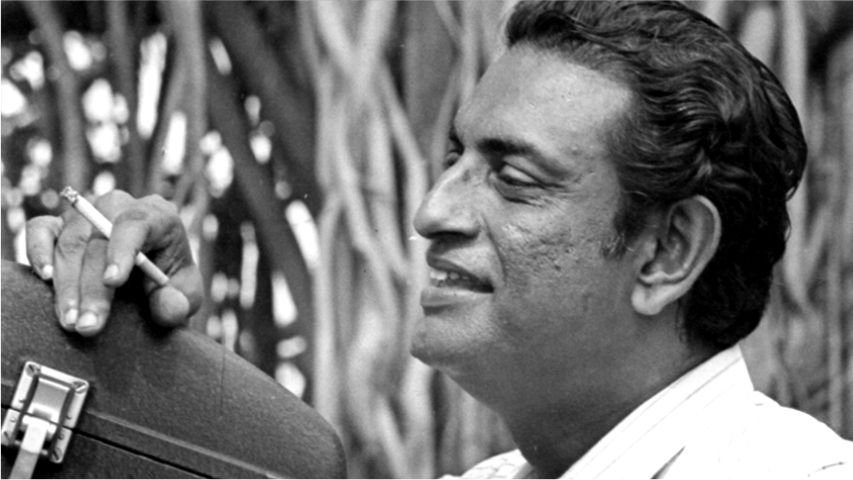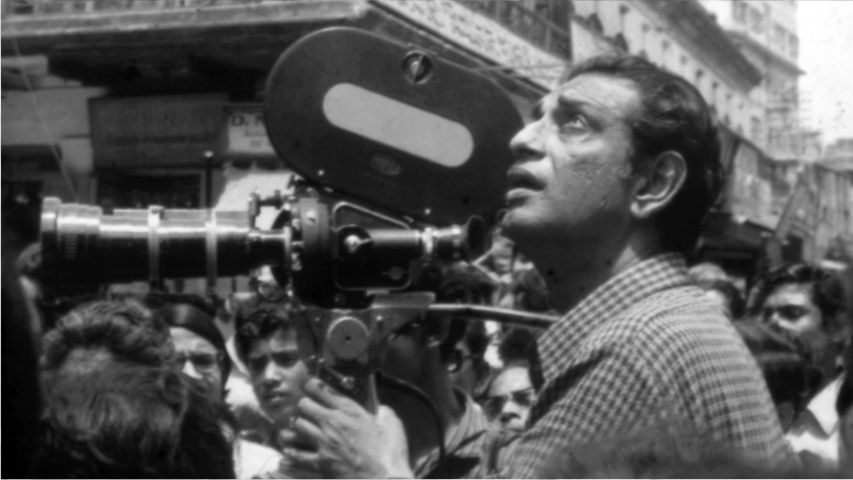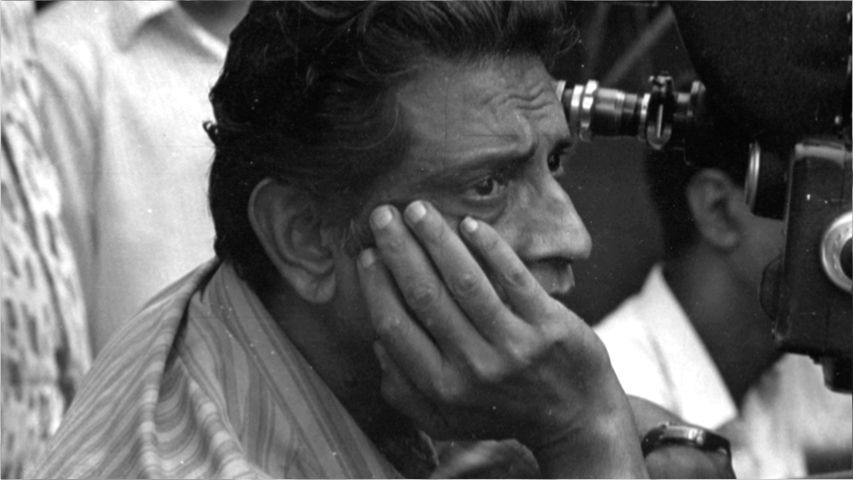-original-853X543.jpg)
Satyajit Ray: The man who knew too much
by Shantanu Ray Chaudhuri April 23 2022, 12:00 am Estimated Reading Time: 11 mins, 50 secsIn a new book, Barun Chanda, who acted in Satyajit Ray’s Seemabaddha, goes down memory lane about his experiences of working with Ray. Shantanu Ray Chaudhuri writes on the book and the author, and we are privileged to carry the first excerpts from the book.
Editorial Note: Even a hundred years after he was born, and thirty years after he passed away, the works of Satyajit Ray continue to be discussed. If ever there was an auteur of cinema in the truest sense, it was he - there was not a single department of filmmaking that he did not address: the script and dialogue, the music, costumes, the posters, the title cards. No wonder, books on him continue to be written. The latest in this is Barun Chanda’s Satyajit Ray: The Man Who Knew Too Much.
Satyajit Ray’s Seemabaddha (1971), a stinging indictment of the corporate rat race, remains one of the iconic filmmaker’s most feted works. The second of his much-lauded Calcutta Trilogy, it starred debutant Barun Chanda, winning him a special prize for his performance.
Now, fifty years later, Barun Chanda documents his experience of working in the film and being directed by Satyajit Ray, someone he describes as ‘the man who knew too much’. The actor begins with an account of his first meeting with Ray for an interview on behalf of Junior Statesman, which got off to the worst imaginable start as the Garrard, 5-inch spool recorder he had taken with him refused to play. He managed to salvage the situation and the interview was well received. From thereon he became a part of Ray’s ‘magic circle’ and his Sunday morning addas, acted in one scene (with his back to the camera) in Pratidwandi, before landing the lead in Seemabaddha.
In breezy anecdotal style, Barun Chanda provides an up-close and intimate account of the making of an Indian classic, from its casting to its release, the attention to detail Satyajit Ray brought to every aspect of the film, and the relationship between one of the world’s greatest directors and an actor making his debut. But the book is more than just an account of the making of a film.
The author also presents a detailed and informative study of the various avatars of Ray as a filmmaker: his sense of script and ear for dialogue, his instinctive grasp of the nuances of music, his penchant for casting non-actors and ability to get the perfect face for a role, his genius in designing a film’s title sequence. He also speculates on the kind of man Ray was and asks the dramatic question: was Ray a dictator or director? Insightful and informed by a rare understanding of the master’s works, this is an invaluable addition to the corpus of work on Satyajit Ray.

After obtaining a master’s in English, Barun Chanda taught for a while in a college, before moving over to advertising, which he confesses, was an absolutely exhilarating experience. In between he appeared in Satyajit Ray’s Seemabaddha as its protagonist. Early in 2000 he decided to quit advertising and become a whole-time writer. Film offers started pouring in again after a self-imposed exile of twenty years.
Today, Barun has three enduring passions in life - acting, writing and travelling, but not necessarily in that order. He has four Bengali and two English books to his credit, the last two being Coke and Murder in the Monastery, both crime thrillers. This book on Ray is his first non-fiction work.
The following excerpts are reproduced with the permission of Om Books International
First Day, First Shot
We were in Patna. For the first shot of the day, Ray placed the camera on top of the footbridge in Patna railway station. Ray had made inquiries in advance and knew the exact time when an express train was to leave a particular platform. He had mounted the camera right on top of the passage of the train, so that when the train actually departed it blew a cloud of steam and smoke right into the lens of the camera. Remember, Indian Railways had only steam engines in 1970. Ray was happy with the shot. It was the only take and it was okay.
I was not required for the shot but I hung around, hungrily observing whatever Ray was doing. After the railway station part was over, the unit moved over to Patna College. In the film I played the role of a lecturer at the college. And as soon as my classes were over I was to set out for an interview at the local Hindusthan Peters office for a job. And for that I had to travel on a bicycle. For the interview scene, Manik-da had a specially tailored cotton suit made out for me. I also wore a tie and a moustache. I used to keep a moustache at the time.
The cycling shots inside the college went off uneventfully. My travel route from college to the Hindusthan Peters office included the most easily recognizable landmark in Patna, the Golghar. Originally constructed as a granary for British soldiers in 1786, this huge dome-like structure, some 29 meters high, is now a popular tourist attraction. On the outer surface of the dome, a winding staircase that skirts around its fat belly goes right up to the top, providing a splendid, panoramic view of the city.
But a word of caution - it’s not for the weak hearted. Much, much earlier, when I was just a kid, and studying at St. Xavier’s School in Patna, I had actually lived in Patna for about three years, much like the story of Seemabaddha, out of sheer bravado I had climbed up to the top. And I tell you, getting down was one of the creepiest, scariest experiences of my life. That day I learnt the true meaning of vertigo.
To come back to the bicycle shot, Ray had mounted the camera on the back of a jeep. It required removing the rear seats and strapping up the camera tightly to the body of the vehicle. It must have been a very uncomfortable arrangement for Ray had to squeeze his huge frame into that small space and crouch behind the camera to look through the viewfinder. But, he seemed to be able to shoot the scene apparently without any discomfort.
The route that I was to take was the road that girdles the Gandhi Maidan, leading up to the Golghar. The jeep was to precede me. Ray explained that he would try and have the jeep driving at a moderate speed so that I had no difficulty keeping up with it.
“Try and keep a distance of 10 to 15 feet between our jeep and your cycle.” I nodded silently. I assumed he was using a 35mm lens that gave him greater latitude in terms of focus. At that time I was shooting corporate films, documentaries and ad films on a regular basis for Clarion. So, I had a fair idea of what lenses to use for which shot.

In the middle of the take a problem manifested itself for which I wasn’t prepared. As I kept following the jeep there was a bullock cart that came into our path. After overtaking the cart the jeep went back to the left lane. But, when I was to overtake the bullock cart I ran the risk of momentarily going out of frame. I had to decide on the spot whether to carry on with the shot or ask for a retake. But, since Ray didn’t signal anything I carried on. And in the film it looked realistic enough.
Just then I thought up a little improvisation. If this guy, I reasoned, is going to appear for an important interview won’t he be worried about being on time, especially when he’s cycling all the way? So, shouldn’t he look at his wristwatch once? That’s exactly what I did in that scene.
Apparently, this piece of improvisation didn’t go unnoticed by Ray who was supposed to have remarked, “That’s a nice touch.” I learnt this later from Sandip Babu, Ray’s son, with whom I had become quite friendly by then. Ray uses this shot as a cutting point for the interview at Hindusthan Peters.
Day two was a free day for me. Ray was going to shoot my point of view (POV) shots. I wasn’t required for them. Even if I wanted to stay with the unit it wouldn’t have been possible. There was so little space in the jeep. So, I decided to spend the morning with Mrs. Bijoya Ray. While the rest of the unit had been put up in different hotels, Ray and Boudi had been accommodated at a zamindar’s Patna residence on Frazer Road. I knew where the house was. While going to St. Xavier’s School years ago, I had to walk down Frazer Road every day. It was a large two-storied palatial building with a veranda that overlooked a lawn. Since the Rays were staying on the first floor, Boudi took me to this veranda and made me sit there.
In due course of time, a Khansama arrived and served us tea and savories on a tray. Boudi was such a sweet person; she could make anyone feel at ease in minutes. In any case she was doing the bulk of the talking and I was doing the listening. And, out of the blue she said something that I never forgot.
She said the previous night, Manik had told her he could think of making Gora now. Gora, as everyone knows, is one of the most celebrated, and, at the same time, controversial novels ever written by Rabindranath Tagore. For Ray to even think of me as a potential Gora was unbelievable. At that moment I was even willing to barter away my role in Seemabaddha for just a written statement from Ray saying what Mrs. Ray had just conveyed to me. I would have kept that written statement properly framed in my drawing room as the most valuable document in my life. I looked back at the lawn and suddenly the tall palm trees seemed to leap up at the sky before coming down and hitting terra firma. It took some time before the palm trees regained their normalcy.
The only time something of this nature had happened to me before was during my university days when I had consumed almost a full bottle of rum.

My Secret Tryst with Sharmila Tagore
Though we were supposed to be together in the car while picking her up from Howrah Station, I hadn’t actually met Sharmila. I also knew that she was supposed to be shooting with her screen-sister and my screen-wife, at Hotel Hindustan International (HHI). The scene was somewhat like this. My sister-in-law, Sudarshana, had just arrived from Patna and was staying with us. And obviously we were supposed to be taking her around to fancy places, partly to show off that we had ‘arrived’ and partly to keep her entertained.
That particular afternoon my wife was supposed to take her sister for lunch to HHI, and I was supposed to join them directly from the office. But, all of a sudden, a most serious crisis takes place in the fans division of which I am in charge and I forget all about my lunch appointment with my wife and sister-in-law.
That’s the scene at HHI. Obviously I’m not required in this shot. So, what if I was to visit the hotel surreptitiously, and meet up with her by posing as an ardent fan and seeking her autograph. She had never met me before and I was hoping Ray hadn’t shown any photograph of mine to her. If she were to ask for my name I had a ready answer for it. And you could be sure I was going to use a fictitious name for myself. So, if I could only meet her privately without Manik-da’s knowledge the trick would be on. I would be dying to watch her face when she would actually get to know who I was. Would she be annoyed with me that I had played a trick on her? Or, would she blush a hot shade of pink?
After reaching Hotel HHI I headed straight for the dining room because I knew that’s where the shoot was going to take place. The dining hall was a hub of activities. Crewmembers of Ray’s unit were busy setting up the lights. There was the usual hotel staff, running around excitedly, taking orders. And then there was the army of journalists and photographers from the press. Oblivious to all the chaos around him, Ray was deep in discussion with Soumendu Roy, the cameraman, and his team about camera positioning, lights and everything else.
Relieved, I tiptoed towards where Sharmila was seated. And I was thanking god that Boudi wasn’t there. She would have given my identity away. A lady hairdresser was putting finishing touches to Sharmila’s coiffure. The autograph book in hand, I approached her. And just then, as if propelled by some ‘sixth sense’, Ray turned his eyes off the ‘kheror khata’ and looked directly at me.
“Ah! There you are, Barun,” he exclaimed in his usual booming voice, so that all eyes were turned on me. “Rinku,” he turned to Sharmila and said, “this is Barun, the hero of Seemabaddha.”
All I could do was to avoid rolling my eyes up towards heaven, and extend a weak smile to her. To this day I am at a loss to figure out how Ray became aware of me in the midst of that entire din in that vast dining hall.




-173X130.jpg)
-173X130.jpg)
-173X130.jpg)
-173X130.jpg)
-173X130.jpg)
-173X130.jpg)
-173X130.jpg)
-173X130.jpg)